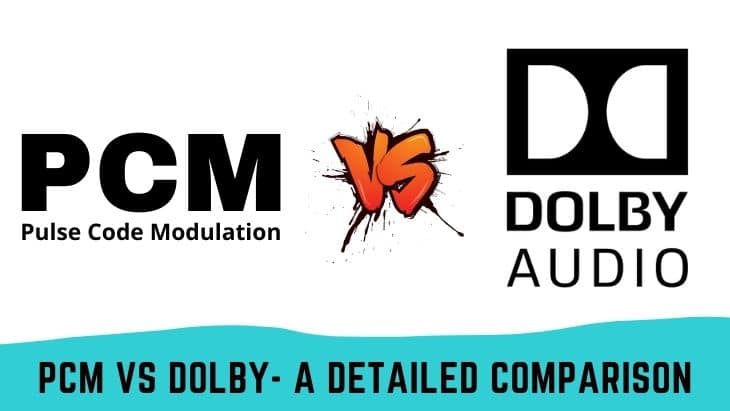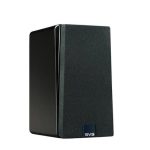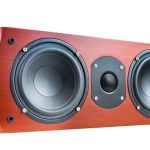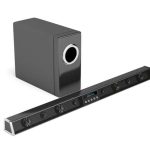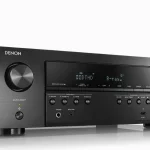It’s always enjoyable to watch movies or play video games, especially when using a surround sound or home theater setup. Sound effects from a home theater system or surround sound speakers can make your movie watching or game playing experience more exciting. However, getting the best quality sound output requires superior audio recording, conversion, compression, and transmission technology.
There’re several audio conversion and transmission technologies used in modern home theater systems and TVs. The most popular options are PCM and Dolby Digital. It’ll help to understand both technologies to help you determine the better option for your home theater sound system. In this article, we’ll compare PCM vs Dolby in detail.
What is PCM?
Pulse-code modulation (PCM) is a digital audio standard for sampling and encoding analog signals. In PCM, data in an analog signal undergoes sampling and encoding in binary numbers. In simpler terms, PCM is a standard that digitally represents sampled analog signals. Essentially, PCM is used in digital telephony, computers, and compact discs among other digital formats.
PCM carries stereo audio signals, which include the right and left audio channels. As such, it lacks support for surround sound. For instance, if you hook a receiver or TV to a DVD player or CD player, it’ll indicate PCM to match the audio format.
There’re several elements that PCM uses to convert analog audio signals into digital audio signals. These elements include:
1. Sampler
The sampler samples data that’s collected instantaneously. Thereafter, it reconstructs the collected message.
2. Low pass filter (LPF)
The LPF eliminates high frequencies in an analog signal that are beyond the frequency of the message.
3. Quantizer
In PCM, the quantizer gets a sample output from the PCM sampler. It minimizes redundant bits from an audio signal. Next, it compresses the signal values.
4. Encoder
The role of the encoder is to digitize analog signals with binary codes. Also, it reduces the bandwidth of a signal to ensure it consumes less bandwidth during transmission.
5. Regenerative repeater
Its role is to increase the strength of a signal. Also, it compiles signal loss.
6. Decoder
The decoder decodes the coded waveform back to its original state.
7. Reconstruction filter
A decoded signal passes through a reconstruction filter to get back to its original state.
Advantages of PCM
PCM offers numerous advantages including:
- Doesn’t cause data loss
- Transmits signals uniformly
- Not prone to noise
- Transmits data securely
Disadvantages of PCM
- A lot of bandwidth is required to transmit data
- There’s some overloading whenever the modulating audio signal changes between the samplings
What is Dolby?
Dolby Digital is an audio compression technology that contains several discrete sound channels. It’s popularly used in home theaters and surround sound systems. The most commonly used Dolby mode is a 5.1 channel setup. The five channels include left surround, right surround, left channel, right channel, and center channel speakers. The extra .1 channel is for a subwoofer.
Basically, Dolby audio is designed to work with sound systems in big rooms and home theater or surround sound setups. Dolby digital is advantageous in that it generates audio that creates cinema-like sound effects. Dolby is also used in HD TVs, digital cables, DVDs, and satellite transmission.
Advantages of Dolby
- It’s easy to access the Dolby software
- Offers excellent audio output
- Outputs sound in multiple channels
Disadvantages of Dolby
- Audio and video may degrade due to extreme compression
Which Audio Conversion Technology Is Better Between PCM Vs Dolby?
As previously mentioned, PCM is used for converting analog audio signals into digital signals. For example, if a DVD has a PCM label, it contains a 2-channel (stereo) audio track. On the other hand, Dolby combines several formats in multiple channels and is used for film audio and home theaters.
Most audiophiles prefer Dolby over PCM. The reason behind their preference is that Dolby has more channels than PCM. However, it’s important to understand the option that matches your TV inputs and outputs. For instance, PCM is better than Dolby when playing video through a DVD player. On the contrary, Dolby is better when using a HD TV in a home theater or surround sound speaker setup.
However, if you’re using built-in TV speakers or left and right stereo speakers for audio, PCM will offer better sound quality than Dolby. The reason behind this is that PCM doesn’t compress audio like Dolby. Thus, there’s less loss of data. If you try using Dolby with built-in TV speakers, you may get low-quality audio and muted tones.
Switching Between PCM Vs Dolby on TV
You may want to switch between PCM and Dolby depending on the input and output devices you’re connecting to your TV. For instance, connecting a satellite receiver, DVD player, game console, or computer to your TV makes them input devices. The devices that receive audio from the TV such as surround sound speakers or a soundbar are the output devices.
The audio format to choose will depend on the output device you’re connecting to your TV. Most modern TVs offer both Dolby and PCM. If you’re using the built-in TV speakers, you’ll need a 2-channel audio output. In this case, choose PCM. However, if you’re connecting a soundbar or home theater system to your TV, choose Bitstream to deliver Dolby Digital audio.
However, some TVs may not offer Dolby Digital. In that case, you can go ahead and use PCM. If your TV lacks both options, then you can set it to automatic settings for optimum performance.
Final Thoughts
When choosing between PCM vs Dolby, your choice should depend on your sound system setup and the audio settings on your TV. Just ensure you match the TV input and output to the best audio conversion format. For instance, PCM is better when using a standard DVD player as the input and the built-in TV speakers as the output. On the other hand, Dolby is ideal for HD TV viewing, satellite decoders, home theater, and soundbar.
Michael Evanchuk is a San Francisco-based sound engineer with 20 years’ experience installing, troubleshooting, and repairing commercial, automotive, and household sound equipment. Evanchuk owns an auto stereo center, where he offers highly competitive car audio installation and repair services. He has written dozens of articles on different sound engineering topics, all of which have been published in leading journals, blogs, and websites.

